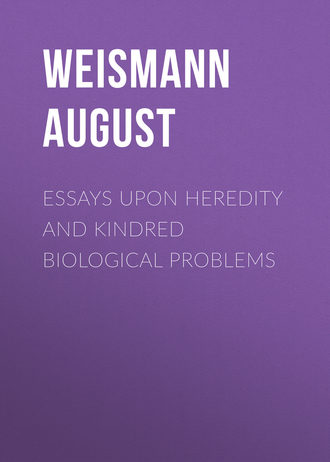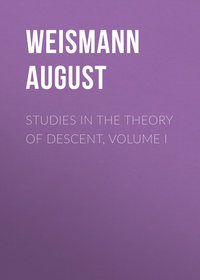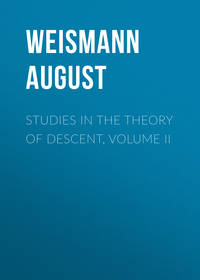 полная версия
полная версияEssays Upon Heredity and Kindred Biological Problems
The conclusions of the author are as follows: ‘Twins who closely resembled each other in childhood and early youth, and were reared under not very dissimilar conditions, either grow unlike through the development of natural characteristics which had lain dormant at first, or else they continue their lives, keeping time like two watches, hardly to be thrown out of accord except by some physical jar. Nature is far stronger than nurture within the limited range that I have been careful to assign to the latter.’ And again, ‘where the maladies of twins are continually alike, the clocks of their two lives move regularly on, and at the same rate, governed by their internal mechanism. Necessitarians may derive new arguments from the life histories of twins.’
The above facts and conclusions held for twins of the same sex, of which at any rate the majority are shown by Kleinwächter’s observations to have been enclosed in the same embryonic membranes, and therefore presumably to have been derived from a single ovum; but in rarer cases the twins, although also invariably of the same sex, were marked by remarkable differences, greater than those which usually distinguish children of the same family. Mr. Galton met with twenty of these cases. In such twins the conditions of training, etc. had been as similar as possible, so that the evidence of the power of nature over nurture is strongly confirmed. Mr. Galton writes, ‘I have not a single case in which my correspondents speak of originally dissimilar characters having become assimilated through identity of nurture. The impression that all this evidence leaves on the mind is one of wonder whether nurture can do anything at all, beyond giving instruction and professional training.’
The fact that twins produced from a single ovum seem to be invariably of the same sex is in itself extremely interesting, for it proves that the sex of the individual is predetermined in the fertilized ovum.—E. B. P.]
273
Fol, Recherches sur la fécondation et le commencement de l’hénogénie: Genève, Bâle, Lyon. 1879.
274
Born, ‘Ueber Doppelbildungen beim Frosch und deren Entstehung.’ Breslauer ärztl. Zeitschrift, 1882.
275
See the second Essay.
276
Consult ‘Ueber die Vererbung,’ Jena, 1883; ‘Die Kontinuität des Keimplasmas,’ Jena, 1885; ‘Ueber die Zahl der Richtungskörper und über ihre Bedeutung für die Vererbung,’ Jena, 1887. These papers are translated as the second, fourth and sixth Essays in the present volume.
277
See the second Essay.
278
[See R. Meldola in Ann. and Mag. Nat. Hist., 1878, vol. i. pp. 158-161. The author discusses many cases among insects in which instinct is related to protective structure or colouring: he also considers that instinct is to be explained by the principle of natural selection which accounts for the other protective features.—E. B. P.]
279
[See ‘Nature,’ vol. 36, pp. 491-507.—E. B. P.]
280
[See ‘The Factors of organic Evolution’ in ‘The Nineteenth Century’ for April and May 1886.—E. B. P.]
281
See ‘Biol. Centralbl.’ Bd. VII. No. 23.
282
See the next Essay (VIII).
283
Detmer, ‘Zum Problem der Vererbung,’ Pflüger’s Archiv f. Physiologie, Bd. 41, (1887), p. 203.
284
[Dr. Weismann is here alluding to experiments upon the larvae of Rumia Crataegata. A short account of the results will be found in the Report of the British Association at Manchester (1887), and in ‘Nature,’ vol. 36, p. 594. I have now obtained similar results with many other species (see Trans. Ent. Soc., Lond. 1888, p. 553); but many of the results are as yet unpublished.—E. B. P.]
285
[See the editorial notes by Raphael Meldola, in his translation of Weismann’s ‘Studies in the Theory of Descent’ (the Essay on ‘The Origin of the Markings of Caterpillars,’ pp. 241 and 306): also E. B. Poulton, in ‘Proc. Roy. Soc.,’ vol. xxxviii. pp. 296-314; and in ‘Proc. Roy. Soc.,’ vol. xl. p. 135.—E. B. P.]
286
[Professor Meldola first called attention to the scattered instances of the kind here alluded to by Professor Weismann, in 1873: see ‘Proc. Zool. Soc.,’ 1873, p. 153. The author explains the relation of this ‘variable protective colouring’ to other protective appearances, and he is strongly of the opinion that the former as well as the latter is to be explained by the action of the ‘survival of the fittest.’
The validity of Dr. Weismann’s interpretation of these effects as due to adaptation, through the operation of natural selection, is conclusively proved by the following facts. The light reflected from green leaves becomes the stimulus for the production of dark brown pigment in those cases in which the leaves constitute the surroundings for many months. Under these circumstances the leaves of course become brown at a relatively early date, and protection is thus afforded for the remainder of the period, although the dark pigment is produced before the change in the colour of the leaf. Instances of this kind are seen in the colours of cocoons spun among leaves by certain lepidopterous larvae (see ‘Proc. Ent. Soc. Lond.,’ 1887, pp. l, li, and 1888, p. xxviii), the cocoons of the same species being of a creamy white colour when spun upon white paper.
Conversely, the light reflected from the same surfaces serves as the stimulus for withholding pigment in the cases alluded to by Dr. Weismann (larvae of R. Crataegata, &c.), in all of which the organism only remains in contact with the leaves while they are green, viz. at a time when the dark colour would be disadvantageous.
Hence precisely opposite effects are produced by the operation of the same force; the nature of the effect which actually follows in any case being solely determined by the advantage afforded to the organism.—E. B. P.]
287
Compare Sachs, ‘Lectures on the Physiology of Plants,’ translated by H. Marshall Ward, p. 710.
288
Compare Biol. Centralbl. Bd. VII. No. 21.
289
I have used the expression ‘transient’ (‘passant’) in the same sense as ‘acquired,’ in order to enforce the conclusion that they are merely temporary, and disappear with the individual in which they arise. Since the characters of which Hoffmann speaks are hereditary, the term cannot be rightly applied to them, and I shall prove later on that they cannot be regarded as acquired characters in the sense required by the theory of descent.
290
Compare a paper by J. Orth, ‘Ueber die Entstehung und Vererbung individueller Eigenschaften,’ Leipzig, 1887. This author considers my theory of the non-transmission of acquired characters to be incorrect, because he will insist upon using the term ‘acquired’ for those characters which are due to spontaneous changes in the germ; although he considers that they are only indirectly acquired. He also reproaches me with not having discriminated with sufficient clearness between the two modes in which new characters are acquired by the body, and with having altogether failed to take into account the class of characters which are due to variations in the germ. On the very same page he quotes the following sentence from my writings:—‘Every change of the germ-plasm itself, however it may have arisen, must be transmitted to the following generation by the continuity of the germ-plasm; and hence also any changes in the soma which arise from the germ-plasm must be transmitted to the following generation.’ Not only does the transmission of Orth’s ‘indirectly acquired characters’ necessarily follow from this sentence, but it is even distinctly asserted by it. I cannot understand how any one who is aware of what happened at the meeting of the Association of German naturalists at Strassburg in 1885, can charge me with the confusion of ideas which has prevailed since Virchow took part in the discussion of this question.
291
His, ‘Unsere Körperform,’ Leipzig, 1874, p. 58.
292
Compare on this point Nägeli in his ‘Theorie der Abstammungslehre.’ This writer also concludes from similar facts that external influences have wrought in the idioplasm, changes which were at first ineffectual, and which only increased during the course of generations up to a point at which they could produce visible changes in the plant. He does not, however, draw the further conclusion that these changes only influence the germ-plasm, for he was not aware of the distinction between germ-plasm and somatoplasm.
293
It is true that he based his opinions upon entirely erroneous theories as to the constancy of species. Compare Brock, ‘Einige ältere Autoren über die Vererbung erworbener Eigenschaften’ in ‘Biolog. Centralblatt,’ Bd. VIII, p. 491 (1888): see also Hugo Spitzer, ‘Beiträge zur Descendenz-theorie und zur Methodologie der Naturwissenschaft,’ Leipzig, 1886, pp. 515 et seq.
294
W. His, ‘Unsere Körperform,’ Leipzig, 1875.
295
See Essay II in the present volume.
296
[One of the most remarkable forms of this revival of Lamarckism is the establishment in America of a ‘Neo-Lamarckian School,’ which includes among its members many of the most distinguished American biologists. One of the arguments upon which the founders of the school have chiefly relied is derived from the comparative morphology of mammalian teeth. The evolution of the various types are believed to be due to modifications in shape, produced by the action of mechanical forces (pressure and friction) during the life of the individual. The accumulation of such modifications by means of heredity explains the forms of existing teeth.
It may be reasonably objected that the most elementary facts concerning the development of teeth prove that their shapes cannot be altered during the lifetime of the individual, except by being worn away. The shape is predetermined before the tooth has cut the gum. Hence the Neo-Lamarckian School assumes, not the transmission of acquired characters, but the transmission of characters which the parent is unable to acquire!—E. B. P.]
297
See p. 412 of the preceding Essay (VII).
298
[See ‘Nature,’ vol. xxix. p. 20, and vol. xxxv. p. 38. In the latter article nine generations are recorded, and in both articles figures of the normal and abnormal feet are given. Additional generations and many more families have been since observed, and an account of these observations will shortly be published in the same paper. The breed originally came from Bristol. In the observations recorded, the abnormality of the offspring is an indication of the hereditary strength of the female parents, while the degree of normality is a similar test of heredity through the male parents; for the female parents were always abnormal, the male parents always normal. The most abnormal kitten observed possessed seven toes on each forefoot, seven toes on the right hind foot (three more than the normal number), and six on the left hind foot. Kittens with seven toes on the forefeet and six on the hind were comparatively common, and all intermediate conditions between this and the normal were of frequent occurrence. Cats with extra toes are, I think, not uncommon in most countries, and the fact that the peculiarity is transmitted is also well known. The object of the investigation alluded to was to observe the transmission systematically through many generations.—E. B. P.]
299
Bonnet, ‘Die stummelschwänzigen Hunde im Hinblick auf die Vererbung erworbener Eigenschaften,’ Anat. Anzeiger, Bd. III, 1888, p. 584; see also ‘Beiträge zur patholog. Anatomie und allgem. Pathologie’ by Ziegler and Nauwerck, Bd. IV, 1888.
300
See the interesting remarks by Döderlein on this point, which Dr. Ischikawa of Japan tells me are quite correct. Döderlein, ‘Ueber schwanzlose Katzen,’ Zool. Anzeiger, vol. x. Nov. 1887, No. 265.
301
It is certainly true that among nations which practise circumcision as a ritual, children are sometimes born with a rudimentary prepuce, but this does not occur more frequently than in other nations in which circumcision is not performed. Rather extensive statistical investigations have led to this result.
302
See Brock, ‘Biolog. Centralblatt,’ Bd. VIII. p. 497, 1888.
303
W. Richter, ‘Zur Vererbung erworbener Charaktere,’ Biolog. Centralblatt, Bd. VIII. 1888, p. 289.
304
This case was not observed by Darwin himself, but was communicated to him by J. P. Bishop of Perry, in North America (see ‘Kosmos,’ vol. ix. p. 458). Quite apart from the fact that it is by no means certain whether the father did not already possess an innate malformation of the thumb, exact data are wanting as to the time during which the thumb was diseased, and as to the time when the malformation of the thumb was first observed in the children and the grandchildren; whether at birth or at a later period. For a thorough criticism it would also be necessary to have figures of the thumbs. I should not have alluded to this case, because of its incomplete history, if it had not appeared to me to illustrate the ideas mentioned above. Of course I do not maintain that I have suggested the right explanation in this particular case. It is possible that the father possessed an inherent malformation of the thumb which he had forgotten by the time that he came to have children and grandchildren, and was struck by the abnormality of their thumbs.
305
See Burdach, ‘Lehrbuch der Physiologie,’ Bd. II, 1835-40, p. 128.
306
See Handwörterbuch der Physiologie von Rud. Wagner, Artikel ‘Zeugung,’ von Rud. Leuckart.
307
See V. Hensen, ‘Physiologie der Zeugung.’ Leipzig, 1881.




